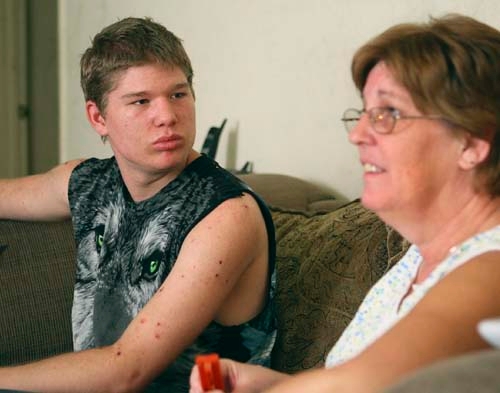Troubled youth leave state because mental health help lacking
Sandy Waide's grandson was having a difficult time in preschool. He ignored his teacher's instructions and refused to sit still. One morning he took a fish out of the classroom aquarium. That ended up being his last day there.
The school told Waide her grandson had a real behavior problem. But she suspected it was more than just that.
"You can tell when something's not quite right," Waide said. "I watched him every day, and all I wanted to find out was what exactly the problem was and how I could get him help for it."
She took Nicholas -- whose name has been changed in this story, to protect his identity -- to doctors who explained that his outbursts and impulsive behavior were attributable to autistic spectrum disorder, Asperger's syndrome, and fetal alcohol and drug exposure.
Getting the diagnoses was the easy part.
The greater long-term challenge became locating effective treatment and schools equipped to help Nicholas develop.
Years passed. Waide found neither.
As Nicholas got older, his grandmother realized she was in a race against time, and she was losing. If she did not find help soon, the juvenile justice system might have to do it for her, even if that meant sending her grandson hundreds of miles from home.
Nicholas ultimately ran out of options in Southern Nevada.
Earlier this summer, after a conviction in juvenile court for lewd behavior, the 16-year-old boarded a plane for Texas. He will spend the next year at the San Marcos Treatment Center, which treats children with multiple psychological disorders.
A few days after Nicholas left Las Vegas, Waide's voice quivered as she talked about her grandson, whom she has raised since birth: "He's 1,300 miles from me. That's hard, really hard. He should have been able to stay here where he grew up."
But Nicholas is just one of many local children currently in other states because Nevada lacks the mental health resources to treat them at home.
As of July, more than 100 children with mental health and cognitive disorders were in out-of-state treatment centers. Many were sent there by child welfare agencies and juvenile courts that concluded appropriate in-state facilities did not exist or were already at capacity. It costs about $75,000 a year, on average, to house Medicaid-eligible children in out-of-state facilities, though not every child has to stay an entire year. Medicaid pays for residential treatment if it is determined medically necessary, and only after all possible in-state options have been exhausted. Medicaid is a federal program administered and partly funded by states, which means Nevada is footing some of the bill for these costly placements.
The number of Southern Nevada youths placed out of state, some as far away as Florida and Alabama, has more than doubled in the past two years, according to the Clark County Children's Mental Health Consortium, a group of advocates, government officials, and mental health professionals that earlier this year released a report about the lack of mental health resources in Southern Nevada.
"Children's behavioral health care funding is miniscule as compared to total healthcare spending, disproportionately small as compared to adult mental health funding, and out of sync with best practices favoring community-based care over residential treatment," the report said.
Mental health officials agree that out-of-state placements, while often necessary in the absence of adequate in-state resources, are undesirable because they limit contact between children and their families.
"We're always concerned about kids going to out-of-state placements if it's because their needs can't be met here," said Diane Comeaux, administrator of the state Division of Child and Family Services. "Families need to be involved in the treatment aspect of kids."
If a child is out of state, and away from a support network, Comeaux said, it creates a challenging situation once the child returns home. The Child and Family Services Division is currently trying to reduce the number of youths sent out of state by patching together services in the community.
Out-of-state placements are symptomatic of a larger problem, said Fritz Reese, director of Clark County's Juvenile Justice Services.
"We've never been able to develop an infrastructure that would allow us to keep our kids in state," Reese said. "Let's face it, Las Vegas is not a traditional community where you've had resources in place for decades and things have gotten better and more polished over time."
Recent studies have shown that Nevada, which spends about $125 million annually on children's mental health services, has fewer public psychiatric beds per capita than nearly all other states. Nevada's spending on mental health agency services is seventh lowest in the nation. Partly as a result, the percentage of Nevada children diagnosed with mental health conditions who are actually getting treatment for those conditions (53 percent) is among the lowest in the country, according to statehealthfacts.org, a website run by the Henry J. Kaiser Family Foundation. Only six states have a lower percentage.
In the absence of public mental health resources, the state has relied heavily on the private sector to fill the void.
A ramp-up of services is unlikely to happen in these hard economic times, but those involved in the issue agree better coordination of resources could help improve things in Nevada. Such improvements to the local system, they say, will help save money in the long run.
"Early intervention always leads to cost savings down the road," Comeaux said. "If we could get younger kids the treatment they need, we could reduce the number of problems they face later."
The Nevada Commission on Mental Health & Developmental Services recently released a long-term proposal to reform the state's current system for delivering mental health services. It includes putting a greater emphasis on front-end services that treat children's problems early in life. "Although one-third of the public children's behavioral health care dollars in Clark County are spent on some type of care management, these efforts are duplicative across agencies, inconsistent, and fail to target those youths with the most serious and complex needs," the report said.
In other words, existing funds could be used more effectively.
"If we can reach those kids earlier, they won't need as many mental health dollars when they get older," said Dr. Julie Beasley, head of the state subcommittee on children's behavioral health planning. "The way we're doing it now is incredibly costly and doesn't work for anybody."
Nicholas' time in school and with county social workers was bookended by visits to Desert Willow and Montevista, local psychiatric hospitals that handle emergency cases.
As a preteen, he would slip out of the house in the middle of the night and walk several miles to homes he thought looked familiar.
"He'd go places where he remembered a bus dropping off somebody in elementary school," his grandmother said. "He was looking for childhood friends."
His impulsive behavior, which included overturning desks and disrobing on the school bus, led to the same question by exasperated teachers: Is he doing these things because he wants to or because there is a problem?
Waide knew the answer. And the problem was getting worse.
By high school, Nicholas was reading at a college level, yet doing math at a second-grade level. He had also developed an addiction to pornography.
"As you go through puberty, other parts of your brain light up," said Waide, who also raised Nicholas' older brother. "Because he did not have his needs addressed earlier, he started adding new layers on top of what he already had."
Nicholas was staying in a local group home earlier this year when he committed a sexual offense that led to four months in juvenile detention and to a court order sending him to the residential treatment facility in San Marcos, Texas.
Family Court Judge William Voy, who presides over juvenile delinquency cases in Clark County, said he has few options in such cases given the state's shortage of adolescent psychiatric programs.
"I don't want to send kids out of state, but sometimes I have no choice," said Voy, who was not the judge in Nicholas's case. "We've not made any progress whatsoever in providing residential treatment for kids in Nevada."
Voy told of a recent incident at a residential treatment facility in Utah where information about a fight involving a Nevada child was slow to get back to authorities here.
"Things got so bad that one of the dads drove up there and pulled his kid out and had him put in detention here," Voy said. "If we could keep kids here, our staff could have a better presence at facilities and do more quality assurance. What we're doing now is outsourcing these kids."
As it stands, state agencies are required to do annual site visits at out-of-state treatment centers.
Though they would have preferred to find treatment locally, some local parents say they were willing to send their children out of state if it meant they would get effective treatment.
When Diane Meeks moved to Las Vegas from Georgia with her daughter, Naomi, and son, John, in 2003, she thought she would have little trouble getting John, then 10, treatment in this area for his autism. "I figured Las Vegas is a big city, and there'd be even more services," she said. "I was wrong."
Her experience instead included long wait lists at treatment centers, psychiatrists who left the area, and a series of short-term hospitalizations prompted by suicide attempts or violent outbursts.
"The problem's been building with every case worker that comes in and then leaves within a few months," said Meeks, who like Waide, has sought help from Nevada PEP, a parent support group for families with children who have mental health and emotional challenges. "Then we go without services for several months. Then he'll end up for a few weeks in the hospital, but he'll leave without any referrals for services."
Many families seeking children's mental health services wind up in local emergency rooms, which have become the gateway for crisis intervention. The county mental health consortium found the number of youths entering emergency rooms for behavioral health problems has nearly doubled in the last four years from about 700 to about 1,400.
In 2007, the Nevada Legislature approved a plan to fund a mobile crisis intervention program, with the goal of reducing the number of emergency room admissions and creating an enhanced system for families to get long-term help once a crisis situation is over. But because of state budget cuts, the program was never launched.
Last year, John Meeks, now 16, was referred to Copper Hills Youth Center in suburban Salt Lake City to take part in the center's Aspergers-Autism Spectrum Disorder Program. And he thrived there. In addition to receiving treatment, he learned pre-algebra and other subjects he had not been taught to that point.
The hard part was building on that positive momentum once he got home.
"It's been a nightmare since he got back, because there were no services for him here when he left, and there still are none," Meeks said.
The families of an estimated 35,000 county children with serious emotional disturbances face a similar dilemma.
Waide hopes her grandson's time in Texas will help him develop into a successful and productive adult.
"I know in my heart he's a good boy," Waide said. "I'm not saying that because I'm a parent. I'm saying that because people who meet him see that he wants to please. But when you don't have the resources in place to steer that and develop that from a very early age, then it will impact kids for the rest of their lives."
Contact reporter Alan Maimon at amaimon@reviewjournal.com or 702-383-0404.
Health




























